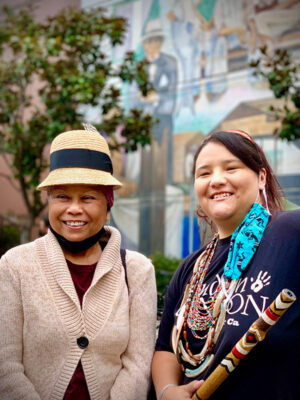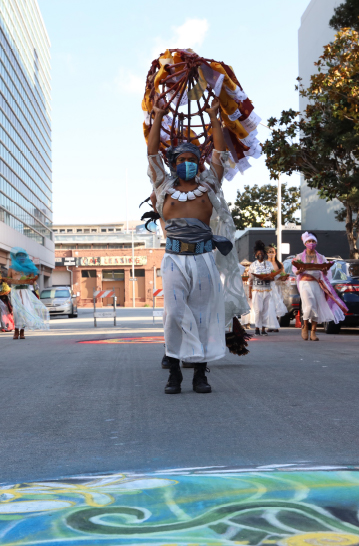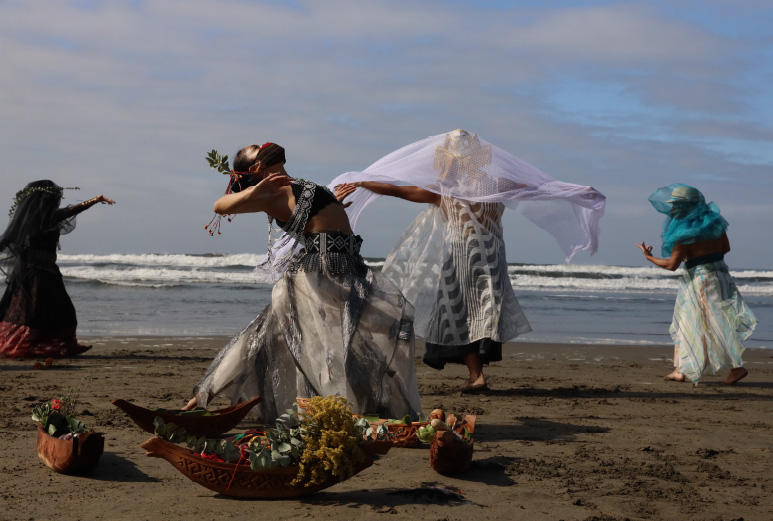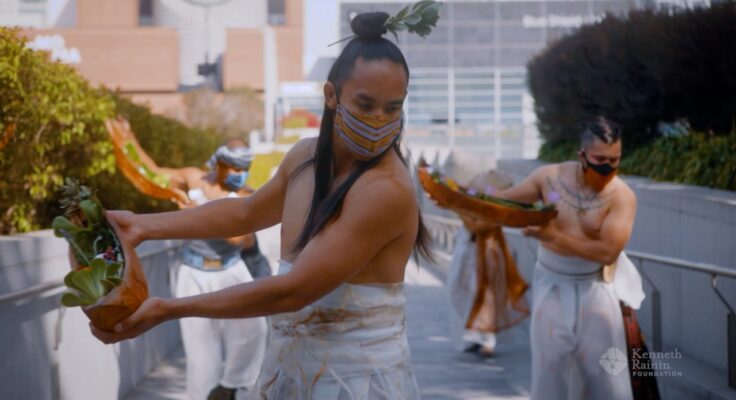Over the course of the pandemic, Bay Area artists reimagined performances and projects in powerful ways. One inspiring example is “Lakbai Diwa: Diasporic Spirit,” featured in the video below, which celebrated the resilience and transformative values of the diasporic Pilipinx people. The Filipino-American Development Foundation, KULARTS and lead artist Alleluia Panis created this project with 35 participating Diasporic and Pilipinx artists and cultural practitioners. The project took place in 2020 and 2021 and featured large-scale ceremonial processions, dance performances and temporary mural painting. These activities centered indigeneity to bring visibility and collective healing to the Pilipinx community in San Francisco’s South of Market neighborhood.
With this visionary project now completed, we invited Alleluia Panis, the lead artist and Artistic Director, to reflect on creating this sacred and meaningful project during the pandemic.
Reflections on “Lakbai Diwa: Diasporic Spirit” Ritual
By Alleluia Panis

In February 2020, three lead dance artists, and I returned home from our immersive trip in the Philippines humbled, honored and energized by the powerful experiences we shared together with tribal communities. We were eager to innovate and forge our own diasporic ritual of healing and reclamation. Sheltered from all the current news while in the remote villages, we were unprepared for what was to unfold.
Pandemic
By March, the COVID-19 pandemic disrupted the world we knew. After weeks of discussion and deliberations with community leaders and artistic team, we all agreed that “Lakbai Diwa” could be a powerful healing ritual to ease the mental and spiritual grief caused by the mounting pandemic casualties, racial-based violence, and the raging California wildfires. After all, performing ceremonies during difficult times has been our ancestral tradition. We began to explore how to step up to this unprecedented challenge.
Partnerships

The vision of “Lakbai Diwa” project as a communal living meditation through the arts would remain, but the production activities we meticulously planned for almost two years would require major modification. By June, we formed a strong community partnership between SOMA Pilipinas, KULARTS, Yerba Buena Gardens Festival, and Yerba Buena Community Benefit District. We developed a robust course of action to meet the demands of strict COVID protocols. We expanded the area of the activities to comply with San Francisco’s social distancing and limited public meeting requirements. The live mural chalk paintings were on Lapu-Lapu and Bonifacio Streets and the moving ceremony of twelve dancers carrying spirit boat offerings processed from the Howard Street overpass through the garden and ending at the Martin Luther King waterfalls. Yerba Buena Community Benefit District assisted with security, street cleaning, and neighborhood support. With city departments shuttered, we sought the help of Supervisor Matt Haney’s office to facilitate the frustrating permitting process and the coordination with city departments. It was a “bayanihan” effort. (Bayanihan is a group of people working together towards a common goal.)
“The murals reflected our innermost hopes and prayers for the power of nature to diminish the virulence of the pandemic.”
Rehearsals were held in parking lots, masks were integrated into the overall costume design, the planned ten foot boat to be carried by two dancers was expanded to fourteen feet, lifts and partnering were excluded in the choreography, and dancers performed with five foot bamboo sticks to discourage close contact with audiences. To further engage communities, we developed and printed poetic deity prayer cards written by three writers and stunning renderings of the diwata/deities in the graphic novel style distributed to those who requested them. We invited folks to write their prayers and wishes on cloth “Lakbai Diwa” prayer flags and individually hung them on the large spirit boat to flutter in the wind. Five muralists were tapped to design and create mandala chalk murals of the five elemental deities on Lapu-Lapu and Bonifacio Streets. The murals were meant to be ephemeral and naturally fade away with time. The murals reflected our innermost hopes and prayers for the power of nature to diminish the virulence of the pandemic.
Audience
The “Lakbai Diwa” ritual performance and the live mural paintings of indigenous deities in a neighborhood where Pilipino people have lived and worked in since the early 1900s was an affirmation of belonging. People came in pods or solo to experience live performance. Elders from the senior housing watched from their windows and balconies. The sonic vibration of the music, the meditative movement of the dance, the sumptuous visuals of the murals, the spirit boat laden with offerings of flowers, turmeric rice and burning incense helped stimulate the senses. Our intention to connect with the universal energies and to transport us in that state of grace was powerfully reflected in the faces of artists and audiences alike.
“The ‘Lakbai Diwa’ ritual performance and the live mural paintings of indigenous deities in a neighborhood where Pilipino people have lived and worked in since the early 1900s was an affirmation of belonging.”
Sadly, our presence was also a threat for those who continue to view us as foreigners. An irate white man who, for reasons that are only clear to him, considered it his right to disrupt the event. Using the community garden’s hose, he attached a power nozzle and vigorously sprayed water at the artist and the mural she was painting. Thankfully, we had secured the necessary city permits. It was a reminder of how far we have come and how far we have yet to go for equity in this country.
“I am so proud of our ability to flow and change course when needed and create something sacred and meaningful…”
It was moving to see the generosity of community partners and all the talented artists who came together to create a beautiful experience with tremendous integrity and grace in spite of the unprecedented hurdles. I am so proud of our ability to flow and change course when needed and create something sacred and meaningful for us artists, the community, and our audience.
“It was moving to witness the power of the arts to uplift the spirit of the people…”
Over that October 2020 weekend we performed a ceremony at a festival on Folsom Street and at Ocean Beach to honor the body of water that connects us to our ancestral homeland and to acknowledge our gratitude to the native Ramaytush Ohlone people. It was moving to witness the power of the arts to uplift the spirit of the people who came upon our performances as well as those who came specifically to take in the ritual. In May 2021, we again held “Lakbai Diwa: Diasporic Spirit” ritual at Yerba Buena Gardens and were invited to perform the ceremony at community gatherings through December 2021.
Connecting Communities Through Temporary Public Art

“Lakbai Diwa: Diasporic Spirit” was supported through the Kenneth Rainin Foundation’s Open Spaces Program. This grantmaking program funds temporary public art that addresses pressing community issues while cultivating connection and creative expression. We invite you to watch the above video to experience this moving project.

